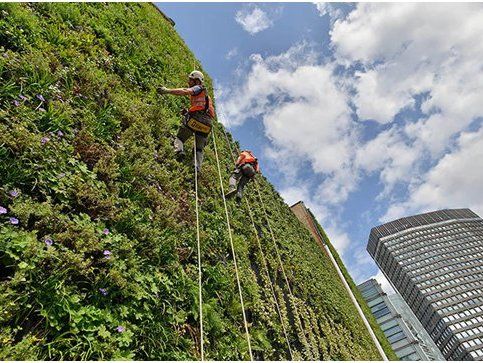Having caught the attention of the society over a year ago, Dr Mike Wells (Bath University) was invited to speak to the Society about the need for more Biophilic ‘nature loving’ architecture. As Bristol now prepares for the 2015’s Green Capital, this lecture was both timely and inspiring.
Ecology and biodiversity are rarely associated with urban space, but by greening the very walls and roofs of our buildings, life can flourish in places dominated by multi-storeys of grey. The vision of meadows and vertical gardens springing up over the concrete jungle is hugely appealing, and that appeal is apparently more than just a superficial preference. ‘Biophilia’ is the idea that humans have an intrinsic love of being around nature – with a substantial amount of research suggesting benefits to our health, wellbeing and even social harmony.
To encourage planners, designers, and importantly individuals who are inspired to add greenery to their community, a heap of practical benefits of living architecture was also offered; the thick soil layer regulates the temperature of buildings; plants can help to filter the urban pollution; soil slows the rate of water run-off allowing drainage systems time to respond; and they provide habitat for wildlife and plants. Importantly roofs can become centres of food production, from allotment scale to herb gardens. Much like on the ground these can be a social space where communities can come together, educate and feed for free. The list goes on – but it is clear that by using the built environment in this radically different way, buildings themselves can become part of the solution to healthier, happier and more sustainable cities.
Mike also put forward a more future orientated case for the biophilic city, which he believes will be part of the solution to the looming “ecological catastrophe”, where expanding global population combined with natural resource depletion sets us on a damning trajectory. Living in compact cities (opposed to the sprawling mega-cities) could be vital to contain further destruction of the planet. High-rise greening could improve the wellbeing of the inhabitants of these densely populated cities, but also be the future of urban food production with expanses of rooftop fields.
In London, Dr Wells recently worked on greening the roofs of the Olympic Park, and there are many examples of this in action with the movement taking off globally. With an initial estimate suggesting around 200 sq.km of potential roof in the UK suitable for green retrofitting, there seem plenty of opportunities to improve the ecology of cities in such a simple and fun way.
To find out more about living roofs in the UK see http://livingroofs.org. And visit http://www.biodiversitybydesign.co.uk/index.php for more on work by Dr Mike Wells.
Molly Gallagher

